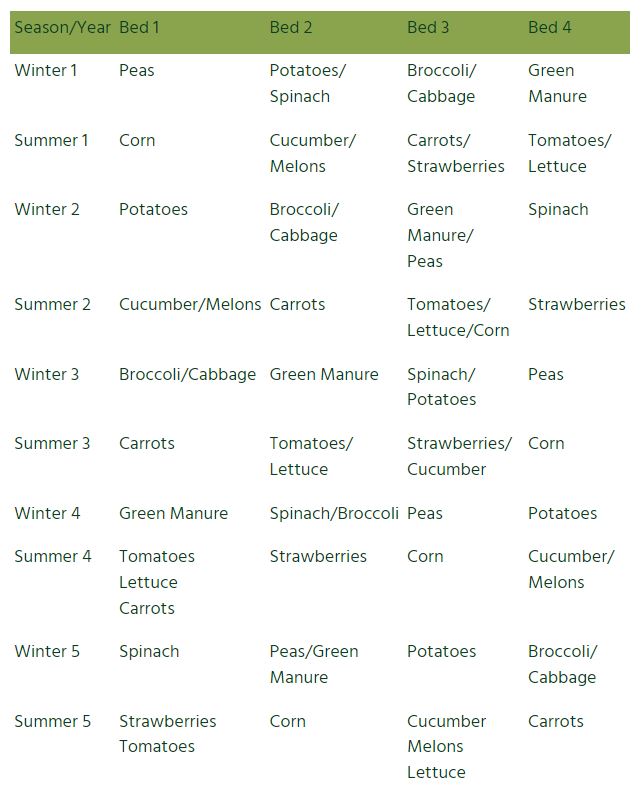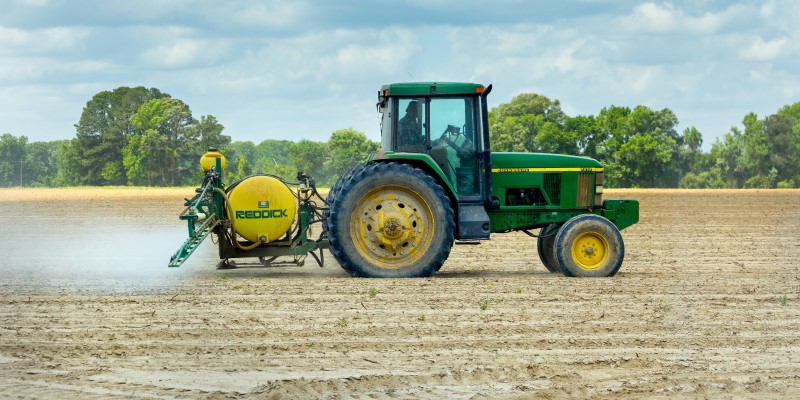Crop rotation is like playing a game of Tetris, but there’s far more at stake than placing blocks in the right spaces for the most points. Crop rotation involves a farmer strategically planning out a crop plan in advance to give them the best chance of having the right nutrients in place for the best yield. While planning can cover the next 12 months, some of the longer-term strategies involve the farmer making a plan that covers the next five years!
In this article, we’ll take a look at the advantages of crop rotation in agriculture to give you an idea as to why farmers go to so much trouble planning ahead.
Key Takeaways
- Higher yields
- Lower input costs
- Reduced pollution to the environment
- Improved soil health
Table of Contents

What is Crop Rotation?
Crop rotation is a farming practice that involves growing different plants in a set order on the same land. As you can imagine, this is more complicated than always planting the same crop (monocropping) or not having a planting plan in place at all (random succession). In some cases, the farmer might even leave the land bare to give it a chance to rejuvenate or allow a herd of sheep or cows to graze for a season.
When a crop is grown using crop rotation, it has numerous benefits for the soil and overall crop yield. One of the main advantages is that it helps improve soil fertility. Different plants interact with soil nutrients in specific ways, helping restore depleted or excess nutrients. Residue from beneficial microorganisms boosts organic matter levels, while leftover biomass from harvesting acts as green manure.
Crop rotation enhances soil structure by affecting nutrient cycling, recycling plant residue, and beneficial microbe development. It reduces soil compaction and creates optimal conditions for seed germination, root spread, water permeation, and air circulation. This ultimately leads to healthier soils and better plant growth.
Crop rotation also plays a crucial role in pest management. By disrupting the life cycles of pests that feed on specific plants, farmers can reduce their reliance on pesticides and minimise infection risks through careful planning.
Crop rotation can significantly improve soil health and fertility, reducing pest pressure and promoting sustainable farming practices.
The Principles of Crop Rotation
Crop rotation is a fundamental agricultural practice involving systematically rotating different crops in a specific sequence within a given piece of land. This practice is guided by principles that aim to optimise soil health, enhance productivity, and reduce the risk of pests and diseases.
One crop rotation principle is crop diversification, where different plant species are cultivated in succession. This helps to break the life cycles of pests and diseases specific to certain crops, reducing their buildup in the soil.
Another principle is alternating crop types, which involves rotating between different plant families, such as legumes, grains, and vegetables. This ensures balanced nutrient utilisation as different crops have varying nutrient requirements.

Additionally, crop rotation improves soil fertility by replenishing nutrients and organic matter, preventing soil degradation, and reducing the reliance on chemical fertilisers. Farmers can achieve sustainable and resilient agricultural systems by adhering to these principles, leading to increased crop yields and long-term viability.
One way that crop rotation improves soil structure is by increasing organic matter in the soil. Different crops have different root structures and nutrient requirements, which can help to break up compacted soil and improve its overall health.
Advantages of Crop Rotation
There are a number of advantages to using this farming method, which we’ll take a look at below.
Increases Soil Health
Farmers can effectively enhance soil health and promote nutrient cycling by rotating crops. Crop rotation improves soil health by preventing soil erosion and increasing soil fertility. It allows different plants to interact with the soil in specific ways. The plant might help to restore depleted nutrients or use up excess nutrients.
Crop residue and leftover biomass from harvesting act as green manure, boosting organic matter levels and enhancing soil structure. This soil improvement creates optimal conditions for seed germination, root spread, water permeation, and air circulation.
| Benefit | Explanation |
|---|---|
| 1. Nutrient Cycling | Distributes nutrient demands more evenly across different crops, preventing nutrient depletion in the soil and enhancing nutrient cycling. Different crops have varying nutrient needs, so rotating them can optimize nutrient utilization. |
| 2. Pest and Disease Control | By changing the type of crops grown in a specific area each season, crop rotation disrupts the life cycles of pests and diseases that target specific plants. This reduces the soil’s buildup of pests and pathogens and minimises the need for chemical pesticides. |
| 3. Weed Suppression | Different crops have different root structures and growth habits. Crop rotation can help suppress weed populations as weeds adapted to one crop may struggle to thrive in the presence of another type of crop. |
| 4. Improved Soil Structure | Enhances soil structure by alternating between deep-rooted and shallow-rooted crops. Deep-rooted crops break up compacted soil and improve aeration, while shallow-rooted crops help prevent erosion and protect the topsoil. |
| 5. Increased Organic Matter | Certain crops, like legumes, add organic matter to the soil through nitrogen fixation and root decomposition. Rotating with such crops boosts soil organic matter content, which improves soil water retention and overall fertility. |
| 6. Reduced Soil Erosion | Can help reduce soil erosion by maintaining continuous ground cover. Different crops can be chosen based on their ability to protect against erosion, minimizing the loss of topsoil due to wind and water. |
| 7. Enhanced Biodiversity | Rotating different crops supports a more diverse range of soil organisms, including beneficial microbes and earthworms. This increased biodiversity can improve soil health by promoting nutrient cycling and natural soil processes. |
| 8. Decreased Soil Degradation | Continuous monoculture can lead to soil degradation – Crop rotation is one way to mitigate this by spreading the impact of specific crops on the soil. This can extend the productive life of agricultural land. |
Overall, crop rotation benefits both the farmer and the environment by improving soil health and ensuring sustainable agriculture practices.

Increases Nutrients in the Soil
Through crop rotation, farmers can effectively enhance soil health and promote nutrient cycling, resulting in increased nutrient levels in the soil. Crop rotation allows for the cultivation of different types of crops in a systematic order, which helps to improve soil fertility and overall crop productivity.
By rotating crops in a specific cycle, farmers can optimise the use of nutrients in the soil and reduce nutrient depletion. This is possible as different crops have varying nutrient requirements and abilities to fix nitrogen from the atmosphere.
Crop rotation thus increases the availability of essential nutrients in the soil, leading to healthier plants and higher yields.
Reduces Soil Erosion
Implementing a crop rotation system reduces soil erosion and promotes sustainable farming practices. By diversifying crops and alternating their planting locations, farmers can prevent topsoil erosion caused by wind and water. This is achieved by using different crop root systems that help the soil become more porous and act as barriers against erosion. Additionally, rotating crops helps to reduce soil compaction, which enhances water permeation, air circulation, and seed germination.
Soil structure and health also benefit from the rotation of crops. Including cover crops or high-residue plants in the rotation adds organic matter to the soil through their residue, improving its fertility and moisture retention capacity. This residue also reduces runoff and erosion during heavy rainfall events.
Implementing a crop rotation system minimises soil erosion by improving soil structure, preventing compaction, and enhancing water infiltration. This increases crop productivity while promoting sustainable farming practices that protect the environment for future generations.
Limits Pests and Diseases
Crop rotation effectively reduces the amount of pests and diseases in agricultural systems. Farmers can limit the buildup of harmful organisms that target specific crops by implementing a specific crop rotation plan. Growing various plants in rotation helps disrupt the life cycles of pests, reducing their overall population and impact on the soil. This crop diversification is essential for maintaining healthy ecosystems within farms and mitigating the risk of widespread infections.
Rotation systems prevent continuous monoculture, where growing the same crop year after year can increase pests and diseases. Instead, by rotating crops, farmers create an environment that is less favourable for these organisms to establish and thrive, resulting in healthier plants and reduced reliance on pesticides. Overall, the advantages of crop rotation include improved pest management and disease control while promoting sustainable farming practices.
Reduces Weeds
By rotating crops, farmers can effectively minimise the growth and spread of weeds in their fields. Crop rotation involves planting different crops in a specific order, which disrupts the life cycles of weeds and reduces weed biomass. Here are three key benefits of crop rotation in reducing weeds:
- Mixes weed species: Rotating crops changes the environment for weed growth, making it difficult for specific weed species to thrive. Different crops have varying effects on weed populations, helping to control them naturally.
- Decreased reliance on pesticides: Crop rotation reduces the need for excessive pesticide use by interrupting the life cycles of pests that feed on specific plants. This environmentally-friendly approach promotes sustainable farming practices.
- Enhanced soil health: Certain crop types, such as legumes, have nitrogen-fixing properties that enrich the soil with this essential nutrient. Adequate nitrogen levels help crops outcompete weeds and promote healthier plant growth overall.
Overall, the implementation of crop rotation into farming practices can significantly reduce weed pressure while improving soil health and sustainability.
Improves Soil Structure
Improving the structure of your soil through crop rotation can have several benefits for your farming practices. The practice of crop rotation allows the soil to replenish and restore its nutrient levels. By rotating different crops, you can avoid depleting nutrients from the soil that are essential for plant growth.
Crop rotation also helps break up compacted soil and improves the overall structure of the top layer of soil. This allows for better water infiltration, root penetration, and air circulation, which are crucial for healthy plant growth. By alternating between different types of crops, it’s possible to prevent the buildup of pests and diseases that typically target one type of crop.
Overall, incorporating crop rotation into a farming routine has numerous advantages in improving crop yield and maintaining long-term soil health by optimising nutrient content in the soil.
Reduces Pollution
Implementing crop rotation in farming practices can greatly reduce the environmental impact of crop production. By growing various crops and rotating them on the land, the farmer can effectively manage soil health and fertility. The benefit here is that it reduces a farmer’s reliance on synthetic fertilisers and pesticides and decreases the release of harmful chemicals into the environment.
Additionally, certain crops in rotation, such as legumes, can fix atmospheric nitrogen into the soil, reducing the need for nitrogen-based fertilisers that contribute to water pollution. Long-term crop rotation also helps prevent nutrient runoff and soil erosion, further minimising pollution risks.
Crop rotation is a sustainable practice that improves yields but also contributes to a cleaner and healthier environment.

Increases Crop Yield
Crop rotation can increase yields by optimising soil health and nutrient availability. The advantages of crop rotation can be realised by planting different crops in a specific sequence. Here are three ways in which crop rotation increases crop yield:
- Nutrient Management: Crop rotation allows for more efficient use of nutrients in the soil. Different plants have varying nutrient requirements and capabilities, so by rotating crops, the soil can replenish essential nutrients that previous crops may have depleted. This results in healthier plants with access to a well-balanced nutrient supply.
- Pest and Disease Control: Planting the same crop year after year can attract pests and diseases that specifically target that plant. Using a crop rotation strategy leads to crop diversity – this diversity interrupts pest life cycles and reduces disease incidence. This helps to maintain plant health and minimise yield losses due to pests or diseases.
- Weed Suppression: Different crops have different growth habits and root structures, which can help suppress weeds by shading them out or competing for resources. By incorporating cover crops or deep-rooted plants into the rotation, weed pressure can be reduced without relying heavily on herbicides.
One study from 2021 found that diverse rotations significantly improved corn yield compared to planting of the same crop year after year. In a two-year rotation, corn yield improved by 29% and up to 48% when grown in a four-year rotation with a winter legume cover crop using in just one of those years.
Practising crop rotation offers several benefits that contribute to increased crop yield. Careful planning and diversifying the types of crops grown on a field over an average crop rotation cycle takes time but leads to long-term improvements in productivity.
What are the Negatives of Crop Rotation?
While the benefits of crop rotation are evident, there are also some negatives that we should look at. The table below lists seven disadvantages or risks of using the rotation process:
| Disadvantage/Risk | Explanation |
|---|---|
| 1. High Initial Costs | Crop rotation requires investment in various crop seedlings and equipment, which can be financially burdensome, particularly for small-scale farmers with limited resources. |
| 2. Potential for Crop Failure and Loss | Different crops have varying requirements and sensitivities to environmental conditions, increasing the risk of some crops not thriving as expected and resulting in financial losses. |
| 3. Spread of Pests and Diseases | Ineffective pest and disease management during crop rotation can spread these issues between crops, causing significant damage to the overall yield. |
| 4. Nutrient Buildup | Improper implementation of crop rotation can lead to nutrient imbalances in the soil, with certain nutrients being depleted or accumulated in ways that affect plant health and yield. |
| 5. Limitations on Specialization | Crop rotation necessitates diversification, limiting a farmer’s ability to specialize in a single crop, which can be less desirable when market demand or personal preference favours one crop. |
| 6. Uncertainty of Crop Success | Different crops respond variably to environmental conditions, making it difficult to guarantee the success of every crop in a rotation cycle, leading to uncertainty in outcomes. |
| 7. Need for Knowledge and Skills | Proper execution of crop rotation demands knowledge and skills in selecting suitable crop combinations, understanding nutrient requirements, and avoiding negative plant interactions. |
Conclusion
Crop rotation is not without its downsides, but let’s not forget about the amazing benefits it brings to the table. Farmers can boost soil fertility, keep pests and diseases in check, achieve higher yields, regulate nutrient uptake, and even improve water use efficiency by rotating crops. It’s a practice that farmers should carefully consider when planning their agricultural operations, however, there are also disadvantages of crop rotation to consider.
About the Author

CHARLIE
Hi, my name is Charlie. I’m the founder of Just Organics. I have a background in Environmental Health and am passionate about animal welfare. I have been using organic products for more than ten years and would like to share my love of products made from nature.
I hope you find value in our articles. If there’s anything you’d like us to write about or if you’d just like to connect with us, feel free to send us a message.
